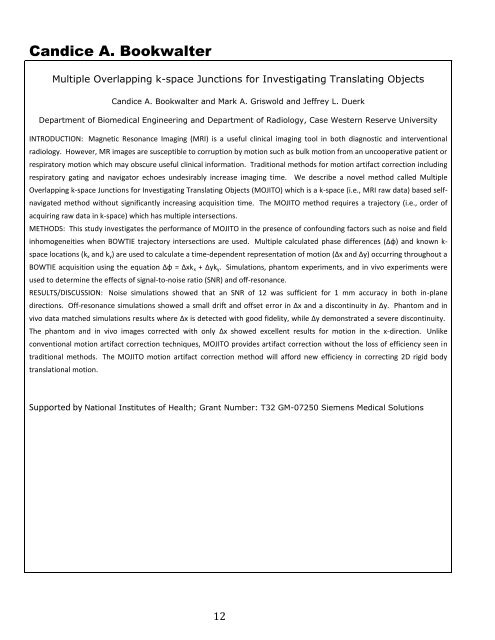student research day - Case Western Reserve University School of ...
student research day - Case Western Reserve University School of ...
student research day - Case Western Reserve University School of ...
Create successful ePaper yourself
Turn your PDF publications into a flip-book with our unique Google optimized e-Paper software.
Candice A. Bookwalter<br />
Multiple Overlapping k-space Junctions for Investigating Translating Objects<br />
Candice A. Bookwalter and Mark A. Griswold and Jeffrey L. Duerk<br />
Department <strong>of</strong> Biomedical Engineering and Department <strong>of</strong> Radiology, <strong>Case</strong> <strong>Western</strong> <strong>Reserve</strong> <strong>University</strong><br />
INTRODUCTION: Magnetic Resonance Imaging (MRI) is a useful clinical imaging tool in both diagnostic and interventional<br />
radiology. However, MR images are susceptible to corruption by motion such as bulk motion from an uncooperative patient or<br />
respiratory motion which may obscure useful clinical information. Traditional methods for motion artifact correction including<br />
respiratory gating and navigator echoes undesirably increase imaging time. We describe a novel method called Multiple<br />
Overlapping k-space Junctions for Investigating Translating Objects (MOJITO) which is a k-space (i.e., MRI raw data) based self-<br />
navigated method without significantly increasing acquisition time. The MOJITO method requires a trajectory (i.e., order <strong>of</strong><br />
acquiring raw data in k-space) which has multiple intersections.<br />
METHODS: This study investigates the performance <strong>of</strong> MOJITO in the presence <strong>of</strong> confounding factors such as noise and field<br />
inhomogeneities when BOWTIE trajectory intersections are used. Multiple calculated phase differences (Δφ) and known k-<br />
space locations (kx and ky) are used to calculate a time-dependent representation <strong>of</strong> motion (Δx and Δy) occurring throughout a<br />
BOWTIE acquisition using the equation Δφ = Δxkx + Δyky. Simulations, phantom experiments, and in vivo experiments were<br />
used to determine the effects <strong>of</strong> signal-to-noise ratio (SNR) and <strong>of</strong>f-resonance.<br />
RESULTS/DISCUSSION: Noise simulations showed that an SNR <strong>of</strong> 12 was sufficient for 1 mm accuracy in both in-plane<br />
directions. Off-resonance simulations showed a small drift and <strong>of</strong>fset error in Δx and a discontinuity in Δy. Phantom and in<br />
vivo data matched simulations results where Δx is detected with good fidelity, while Δy demonstrated a severe discontinuity.<br />
The phantom and in vivo images corrected with only Δx showed excellent results for motion in the x-direction. Unlike<br />
conventional motion artifact correction techniques, MOJITO provides artifact correction without the loss <strong>of</strong> efficiency seen in<br />
traditional methods. The MOJITO motion artifact correction method will afford new efficiency in correcting 2D rigid body<br />
translational motion.<br />
Supported by National Institutes <strong>of</strong> Health; Grant Number: T32 GM-07250 Siemens Medical Solutions<br />
12
















